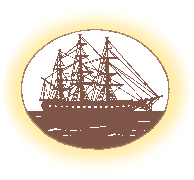
 |
 |

| Getting Started Key Words & Concepts Glossary Activities Recommended Resources Scuttlebutt | ||||
Getting Started  Ask students if they have ever had the experience of being bullied or pushed around. Tell them that countries test their strength too, just as people do. At some point, one needs to draw the line. America came to that point in its dealings with the Barbary states in the early 1800s. | ||||
Key Words and Concepts
Students may remember that Constitution was in the process of being built when an event occurred that threatened to halt her construction. Do they remember what it was? The “treaty” that almost halted Constitution’s construction was a one million dollar cash payment to the Dey of Algiers. The treaty also included the gift of a frigate. Named Crescent and built in Portsmouth, N.H., the frigate was sent to Algiers laden with tribute in 1797. What does the class think of the idea of arming the Dey with a warship to bribe him from attacking American merchant ships?
Peace in the Mediterranean lasted only 15 months. America had paid off the most powerful of the Barbary states, and even though treaties with its neighbors followed, none received as much bounty as Algiers, arousing considerable jealousy. For a while, the United States managed to stop the raids by using diplomacy and by providing larger payments.
On March 4, 1801, Thomas Jefferson became President. He reviewed the situation and decided on a new policy. Since Tripoli (modern Libya) was creating the most trouble, Jefferson wrote to the Bashaw, or leader, of Tripoli that America would send to the Mediterranean a “squadron of observation.” Even though Jefferson assured the Bashaw that the squadron’s interest was only the safety of our merchant ships, he added, “we mean to rest the safety of our commerce on
the resources of our own strength and bravery in every sea.” Ask students to interpret Jefferson’s words. What was his plan to end the raids in the Mediterranean?
Jefferson’s “observation squadron” foreshadowed a more aggressive foray into the Mediterranean. In 1803, Constitution, under the command of Commodore Edward Preble, was sent on an expedition against the Barbary states. The Bashaw of Tripoli had cut down the American flag on May 14, 1801 as a declaration of war. More American ships had been plundered and the American Consulate had been captured in Tangiers, the capital of Morocco.
Ask a student volunteer to write the words “Preble’s squadron” on the board. Explain that Constitution was the flagship, her captain in command of the squadron. Joining her were the frigate Philadelphia and five smaller vessels. What was the squadron total? What is the class’s estimate of the squadron’s total number of officers and men? (The answer is about one thousand.) What did the squadron find when it passed through the narrow Straits of Gibraltar into the Mediterranean? An enemy tens of thousands strong, sailing vessels well suited to the winds and shallow waters of the 600-mile Barbary coast. Assuming there were 25,000 of the enemy, by how many were the Americans outnumbered?
The stronghold at Tripoli was a well fortified city armed with more than 100 long guns facing the sea. It was no wonder that for 300 years the powerful nations of Europe had not succeeded in subduing the Barbary states.
One of the most daring exploits in naval history took place in the port of Tripoli after the frigate Philadelphia fell into enemy hands. You might want to read aloud an account of Philadelphia’s mission, described in hair-raising detail in Tyrone Martin’s A Most Fortunate Ship. Ask students to do a story-mapping exercise identifying characters, plot, suspense, and climax.
Constitution was built to pass the test that she endured in the Mediterranean. Repeatedly, she out maneuvered the enemy, and her battery established her superior prowess. In Preble’s first attack on Tripoli, Constitution was under fire for two hours, yet she sustained little damage, aside from a 24-pound shot lodged in her mainmast. In another attack , she sailed to within 400 yards of the rocks off a fortification and fired over 300 rounds. When the smoke cleared, enemy guns lay silent. Some damage to her rigging and grape shot embedded in her hull were the extent of her wounds.
Her assaults on Tripoli took enemy lives, damaged the city and interrupted the flow of loot from captured merchant ships. In less than a year, the Bashaw had had enough. In 1805, in the captain’s cabin of Constitution, a treaty was signed which would bring the release of U.S.captives and the end of tribute. That same year, under the protection of the squadron, U.S. Marines in Tripoli hoisted the American flag over the fortress at Derne, the first time the stars and stripes were raised over a foreign country. The bullies of the Barbary coast were to play by new rules.
- squadron: group of ships led by a single officer/commodore
- flagship: the chief ship that carries the squadron commander
- battery: the guns of a warship
- round: the ammunition expended when each gun in the battery fires once
| K-4
5-8
9-12
|
 |